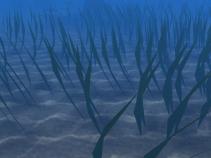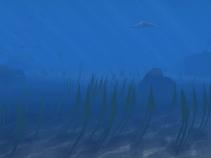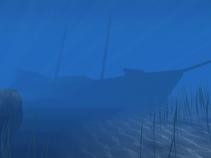
Deep Ocean is sophisticated enough that it has fairly steep hardware requirements. The most important of these is a GeForce 256 or better AGP card. It also needs a 500MHz or faster CPU and 8MB of hard drive space. LI lists the required memory as 64MB, but I was unable to get it running with any less than 128MB.
After providing LI with payment information, you will be given a username and password, valid for a limited period of time. Download the .zip file and run the executable to install it. In the “Screen Saver” tab of the Display Properties menu, select “LI Deep Ocean” and click Preview to begin watching it immediately.
Deep Ocean actually opens into a shallow seabed. An orange soda can descends to the bottom, casting a column of shadow beneath it. A scuba diver, whose first person view comprises the screen saver, sweeps across the sandy bottom, past swaying beds of seaweed as the opening credits play. You find yourself in a pristine blue Eden, where submerged shafts of the sun, split like spun glass, play off great boulders, the sides of schooling fish, the dorsal fin of a dolphin chasing them, and a sunken fishing boat. An occassional crab scuttles by. As the diver, you paddle through this world, lazily investigating the wreck and the rocks and casually observing the fish.
 |
 |
 |
| The
seaweed |
The
dolphin |
The
ship |
This is not pre-recorded animation. It is a real-time simulation of these underwater surroundings and is different each time you run it: the shapes and placement of the boulders, the patterns of the seaweed patches and the route the diver takes as he swims through them all change. It uses OpenGL to generate its effects: LI
says it utilizes bump maps, lightmaps, soft-shadows, reflections, and algorithmically generated geometry.
Copyright
All-About-PC. All rights reserved.
All information on this Website is protected by All- About-PC.
Reproduction and/or sale in any form without agreement of the
publisher is forbidden. All information on this website has been
thoroughly researched and as far as is possible has been verified by
secondary sources, but we can not take responsibility for the
content or for any damages incurred by using this information. |
|



